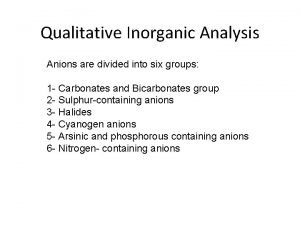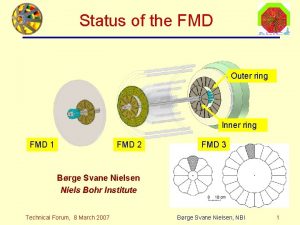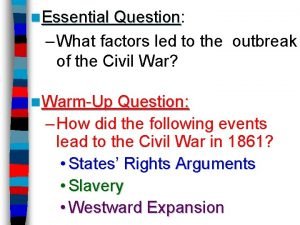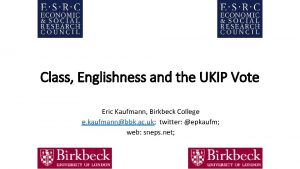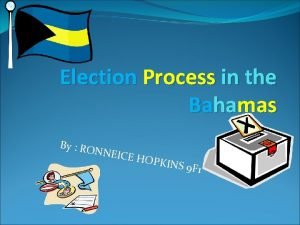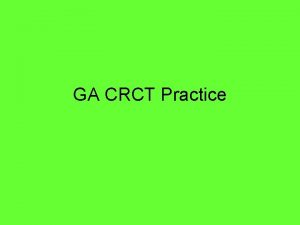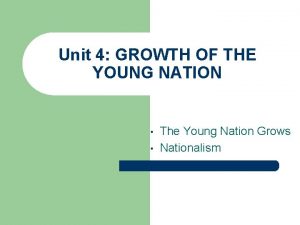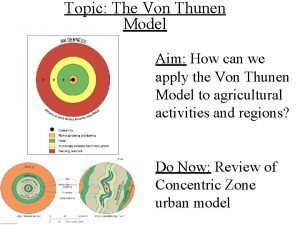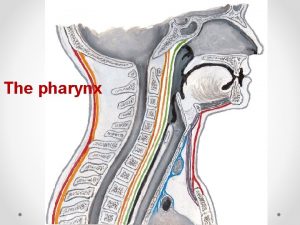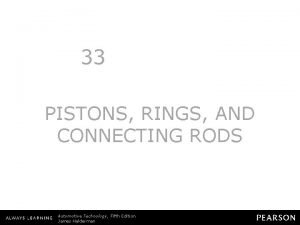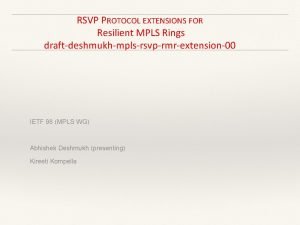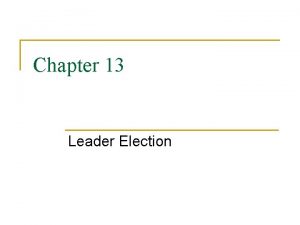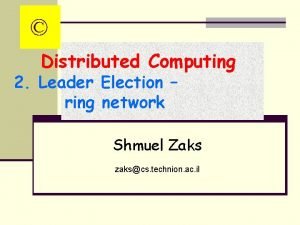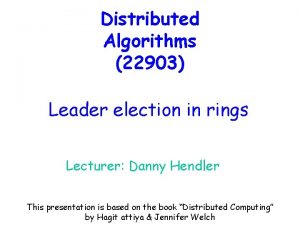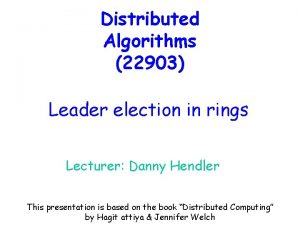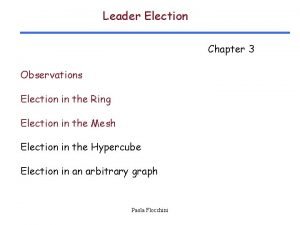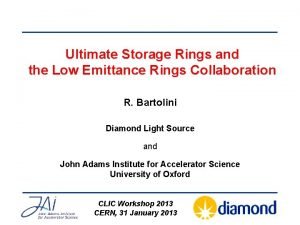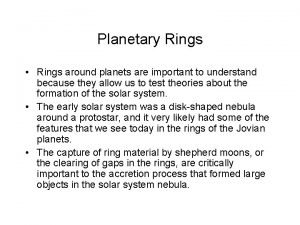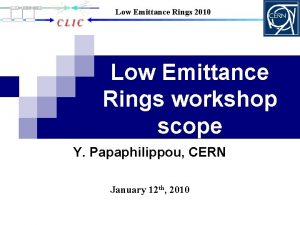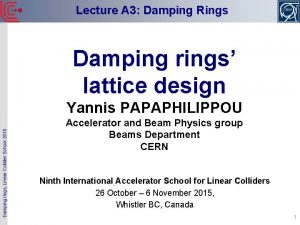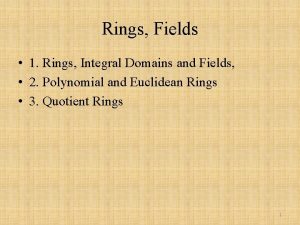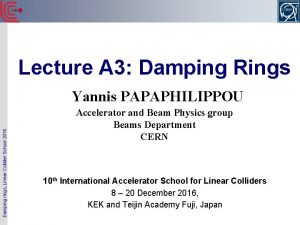Leader Election in Rings 1 A Ring Network































































































- Slides: 95

Leader Election in Rings 1

A Ring Network 2

Sense of direction left 2 right 1 1 2 2 1 3

Links are bi-directional for messages At most one message in each direction 1 2 2 1 4

Anonymous Ring 1 2 2 1 5

Eponymous (non-anonymous) Ring 2 1 1 2 8 1 2 5 2 2 1 1 6 1 3 2 1 7 2 1 4 2 6

Leader Election Initial state Final state leader 7

Leader election algorithms are affected by: Anonymous Ring Eponymous Ring The size of the network Synchronous Algorithm Asynchronous Algorithm is known is not known 8

Synchronous Anonymous Rings Every processor runs the same algorithm Every processor does exactly the same execution 9

Initial state Final state leader If one node is elected a leader, then every node is elected a leader 10

Conclusion 1: Leader election cannot be solved in synchronous anonymous rings Final state leader 11

Conclusion 2: Leader election cannot be solved in asynchronous anonymous rings either Final state leader Why? The asynchronous ring may behave Like the synchronous ring 12

Asynchronous Eponymous Rings The maximum id node is elected leader 8 1 2 5 6 3 7 4 13

Each node sends a message with its id to the left neighbor 1 5 1 8 8 2 5 2 6 3 7 7 4 4 14

If: message received id current node id Then: forward message 1 5 8 2 8 5 6 7 3 7 4 6 15

If: message received id current node id Then: forward message 8 1 7 2 5 6 3 7 4 8 16

If: message received id current node id Then: forward message 7 1 8 2 5 6 3 7 4 8 17

If: message received id current node id Then: forward message 8 1 2 5 6 3 8 7 4 18

If: a node receives its own message Then: it elects itself a leader 8 1 8 2 5 6 3 7 4 19

If: a node receives its own message Then: it elects itself a leader 1 8 leader 2 5 6 3 7 4 20

The leader sends a message in the network declaring itself as the “leader of the ring” 1 8 leader 2 5 6 3 7 4 21

nodes Time complexity: 1 8 leader 2 5 6 3 7 4 22

Message complexity: worst case scenario: nodes 1 n n-1 2 n-3 23

Message complexity: nodes 1 messages n n-1 2 n-3 24

Message complexity: nodes 1 messages n n-1 2 n-3 25

Message complexity: nodes 1 messages n n-1 2 n-3 26

Message complexity: nodes Total messages: 1 n n-1 2 n-3 27

Notes: does not need to be known to the algorithm The algorithm can be converted to asynchronous 28

An O(n log n) Mess. Algorithm Again, the maximum id node is elected leader 8 1 2 5 6 3 7 4 29

nodes 8 1 nodes 2 5 6 3 7 4 30

Phase 1: send id to 1 -neighborhood 1 1 5 8 2 1 5 3 8 8 6 3 7 2 6 5 3 2 4 6 7 7 4 4 31

If: received id Then: send a reply current id 8 1 2 5 6 3 7 4 32

If: a node receives both replies Then: it becomes a temporal leader 8 1 2 5 6 3 7 4 33

Phase 2: send id to 2 -neighborhood 8 1 8 5 5 8 6 5 3 2 6 7 7 7 6 4 34

If: received id current id Then: forward the message 8 1 8 6 5 2 5 8 6 7 3 5 7 6 4 7 35

At second step: If: received id Then: send a reply current id 8 1 2 5 6 3 7 4 36

If: a node receives both replies Then: it becomes a temporal leader 8 1 2 5 6 3 7 4 37

Phase 3: send id to 8 1 8 5 -neighborhood 2 7 7 3 7 8 6 4 38

If: received id current id Then: forward the message 8 1 8 5 2 7 7 3 7 8 6 4 39

At the step: If: received id Then: send a reply current id 8 1 2 5 6 3 7 4 40

If: a node receives both replies Then: it becomes the leader 8 1 2 5 6 3 7 4 41

1 8 leader 2 5 6 3 7 4 42

In general: nodes 1 phases 8 leader 2 5 6 43

Phase i: send id to 1 8 leader -neighborhood 2 5 6 44

Time complexity The leader spends time in Phase 1: 2 Phase 2: 4 … Phase i: … Phase log n: Total time: 45

Message complexity Messages per leader Max #leaders Phase 1: 4 Phase 2: 8 … Phase i: … Phase log n: 46

Messages per leader Max #leaders Phase 1: 4 Phase 2: 8 … Phase i: … Phase log n: Total messages: 47

Notes: The algorithm does not need to know It can be converted to an asynchronous algorithm 48

An Mess. Synchronous Algorithm is known The node with smallest id is elected leader There are rounds: If in round there is a node with id • this is the new leader • the algorithm terminates 49

Round 1 ( time steps): 48 9 15 no message sent 22 nodes 16 33 57 24 50

Round 2 ( time steps): 48 9 15 no message sent 22 nodes 16 33 57 24 51

Round 9 new leader 48 9 15 22 nodes 16 33 57 24 52

Round 9 ( time steps): new leader 48 9 15 messages sent 22 nodes 16 33 57 24 53

Round 9 ( time steps): new leader 48 9 15 messages sent 22 nodes 16 33 57 Algorithm Terminates 24 54

Round 9 ( time steps): new leader 48 9 15 messages sent 22 nodes 16 33 57 24 Total number of messages: 55

Another Synchronous Algorithm is not known The node with smallest id is elected leader 56

The algorithm: • Each node injects a message with its id • Message with id is injected and transferred with rate • Nodes which have seen smaller id absorb higher id messages 57

Time 1 0 4 Transfer rate 0 2 5 6 3 7 1 58

Time 2 0 4 2 5 rate 0 6 3 7 1 1 59

Time 3 0 4 2 5 6 3 0 7 1 1 60

Time 4 0 4 2 5 6 3 1 7 1 0 61

Time 5 0 4 2 5 6 3 0 7 1 62

Time 6 0 4 2 5 6 0 3 7 1 63

Time 8 0 0 4 2 5 6 3 7 1 64

Time 8 New leader 0 0 4 2 5 6 3 7 1 65

Message complexity Assume leader has (smallest) id Total time of algorithm: Note that if is exponentially slow then algorithm 66

Take the node with immediately higher id Total number of messages: 67

Take the node with immediately higher id Total number of messages: 68

lower id messages higher Total messages: 69

An Lower Bound Assume we have algorithms in which: • the network is asynchronous • the maximum identifier is elected leader • all the nodes must know the leader • the size of the network We will prove: at least to elect a leader is not known messages are needed 70

open edge no messages cross it Messages may be pending to cross open edge (i. e. a very slow edge) There is a possible asynchronous execution with an open edge 71

open edge Messages pending to cross open edge Quiescent State If the edge remains open, then the execution will eventually reach a quiescent state where not more messages cross the ring 72

open edge Messages pending to cross open edge Quiescent State In the quiescent state, a node can send a message only after it receives a message (thus no messages cross the ring) 73

Time t Suppose that the edge closes This may cause a propagation of messages until the algorithm terminates 74

Time t+1 This may cause a propagation of messages until the algorithm terminates 75

Time t+2 This may cause a propagation of messages until the algorithm terminates 76

Time t+k k k After k time steps the affected radius is k 77

Time t+x Eventually, the ring stabilizes with a leader 78

We will show, that there is an execution with nodes such that: • there is an open edge • at least messages are received where 79

Proof by induction basis case If x then y is the leader should know about this Therefore a message is sent: 80

open edge x y The message can be sent on one edge 81

The case From induction hypothesis, we have an execution: nodes open edge Messages sent 82

The case From induction hypothesis, we have an execution: nodes open edges Messages sent nodes 83

Observation: If no message is sent along then ring cannot distinguish the two scenarios (similarly for ring ) 84

Therefore, the same number of messages have to be sent in sub-rings True open edge nodes True open edge Messages sent nodes 85

All nodes in max id should learn about open edge (assume that max id is in ) 86

All nodes in should learn about max id (At least one of these is sent) Thus, after the open edges close, messages are sent at least 87

Suppose edges close at time max id At least one message is sent 88

time max id At least one message is sent 89

time max id At least messages have been sent since 90

time radius max id At least messages have been sent since 91

time radius max id Independent areas At least messages have been sent since 92

Messages time radius max id Independent areas At least messages have been sent in one area 93

Messages time radius max id open edge Since areas are independent, we could have closed only one edge 94

Messages time radius max id open edge Total Messages Induction Hypothesis 95
 Hirschberg-sinclair algorithm
Hirschberg-sinclair algorithm Transformational vs transformative leadership
Transformational vs transformative leadership Analysis of anions
Analysis of anions Strong no in c
Strong no in c Oblique canal
Oblique canal Boundaries of inguinal canal
Boundaries of inguinal canal Ding dong, ding dong christmas bells are ringing
Ding dong, ding dong christmas bells are ringing Ring christmas bells ring them loud
Ring christmas bells ring them loud Inner ring and outer ring
Inner ring and outer ring Resilient packet ring
Resilient packet ring Network leader
Network leader Token passing bus network
Token passing bus network Cobra election form sample
Cobra election form sample Win the white house brainpop
Win the white house brainpop Party platform definition
Party platform definition What measures were contained in the alien and sedition acts
What measures were contained in the alien and sedition acts The election of 1800 showed that
The election of 1800 showed that Lincolns election date
Lincolns election date Abraham lincoln's election
Abraham lincoln's election Lincolns election
Lincolns election British election study
British election study Kansas nebraska act
Kansas nebraska act Election day political cartoon
Election day political cartoon 1796 election
1796 election Election of 1836 & rise of mass democracy
Election of 1836 & rise of mass democracy 1932 presidential election
1932 presidential election 1932 presidential election
1932 presidential election Machine selection
Machine selection Vos graffiti
Vos graffiti Importance of election essay
Importance of election essay Strip seal in election
Strip seal in election Thomas county election results
Thomas county election results Election duty certificate for teachers
Election duty certificate for teachers The smallest unit of election administration
The smallest unit of election administration George caleb bingham the county election
George caleb bingham the county election The election process in the bahamas
The election process in the bahamas 1960 election
1960 election John breckinridge opinion on slavery
John breckinridge opinion on slavery Which statement describes a failure in mohandas
Which statement describes a failure in mohandas Fdr election map
Fdr election map Clarity election night reporting
Clarity election night reporting Election of 1824 map
Election of 1824 map State election commission rajasthan
State election commission rajasthan Hume foreclosures
Hume foreclosures Key club election questions
Key club election questions Election of 1824
Election of 1824 Eci dashboard
Eci dashboard Election of 1896
Election of 1896 Dcrc full form in election
Dcrc full form in election Turbomeca tarnos recrutement
Turbomeca tarnos recrutement Arizona multistate service provider election
Arizona multistate service provider election Joslin class rings
Joslin class rings What two things do tree rings indicate
What two things do tree rings indicate Von thunen model rings explained
Von thunen model rings explained Voice box in the respiratory system
Voice box in the respiratory system What was the rising action in the outsiders
What was the rising action in the outsiders The fourth circle of hell
The fourth circle of hell Personal ornaments such as necklaces, rings, or bracelets.
Personal ornaments such as necklaces, rings, or bracelets. How are written codes used in each of this poster
How are written codes used in each of this poster Sharroky hollie rings of culture
Sharroky hollie rings of culture Lipids made up of rigid carbon rings
Lipids made up of rigid carbon rings Jupiter's layers
Jupiter's layers Lipids made up of rigid carbon rings
Lipids made up of rigid carbon rings Why do jovian planets have rings
Why do jovian planets have rings Why do jovian planets have rings
Why do jovian planets have rings Why do jovian planets have rings
Why do jovian planets have rings Bed blocks comfort device
Bed blocks comfort device Matching planet rings
Matching planet rings What is written codes
What is written codes Ring of responsibility
Ring of responsibility Lipids made up of rigid carbon rings
Lipids made up of rigid carbon rings The peon rings the bell passive voice
The peon rings the bell passive voice Dual alliance
Dual alliance Stylopharyngeus
Stylopharyngeus Does jupter have rings
Does jupter have rings Wills rings
Wills rings This phylum name means “little rings”
This phylum name means “little rings” Pistons rings and connecting rods
Pistons rings and connecting rods Annelus means small ring
Annelus means small ring Electron cloud rings
Electron cloud rings Means little rings
Means little rings Wordle 27/1
Wordle 27/1 Why does saturn have rings
Why does saturn have rings Does uranus have rings
Does uranus have rings Mpls rings
Mpls rings Citus altus fortius
Citus altus fortius Book title emojis
Book title emojis Moore's law
Moore's law Fullerene rings
Fullerene rings Circular fascicle arrangement
Circular fascicle arrangement Alliteration advertisement
Alliteration advertisement Wordle 209
Wordle 209 Vulva rings
Vulva rings A shot rings throughout europe
A shot rings throughout europe Liesegang rings oral pathology
Liesegang rings oral pathology Complacent tree rings
Complacent tree rings


